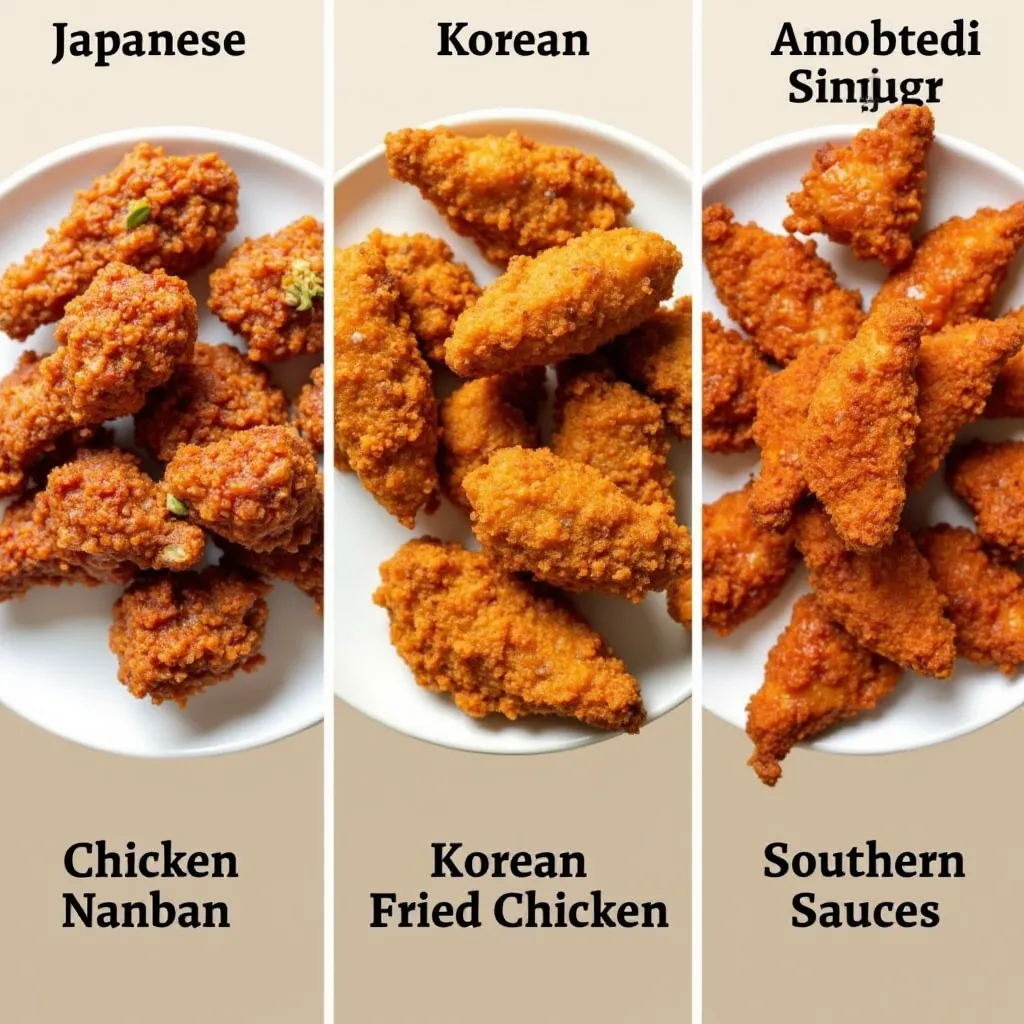Chicken Nanban – A Crispy, Tangy, and Irresistible Japanese Delight
Introduction
Craving crispy, tangy, and creamy all in one bite? Say hello to chicken nanban! This Japanese fried chicken dish stands out with its golden crust, sweet-sour sauce, and rich tartar topping. Originally from Miyazaki, Japan, this dish has gained popularity worldwide, and it’s easy to see why.
In this guide, we’ll walk through everything you need to know about chicken nanban, from its origins and traditional recipe to creative variations and perfect side dishes. Whether you’re a home cook or a food lover, this article will help you make and enjoy this delicious Japanese classic.
Table of Contents
Introduction
What is Chicken Nanban?
Is a Japanese fried chicken dish coated in an egg batter, deep-fried to crispy perfection, and dipped in a sweet and sour sauce. But what truly makes it special? The generous layer of Japanese-style tartar sauce on top. This combination creates an irresistible mix of crunch, tang, and creaminess in every bite.
This dish traces its roots back to Miyazaki Prefecture in southern Japan. It was first served in the 1950s at a local restaurant, but its story goes further back. The name “Nanban” means “Southern Barbarian,” a term used in Japan to describe Portuguese traders who introduced vinegar-based dishes in the 16th century. Over time, these flavors blended with Japanese cooking, leading to the creation of chicken nanban.
Though originally made with bone-in chicken, the modern version uses boneless chicken thighs for a juicier bite. Some people prefer using chicken breast for a leaner option.
Why is Chicken Nanban So Popular?
From Tokyo’s finest restaurants to local Izakayas, He has become a beloved dish across Japan. But what makes it stand out?
- Perfect Flavor Balance: The crispy, golden chicken absorbs the tangy nanban sauce, while the rich tartar sauce adds depth.
- Unique Cooking Method: Unlike karaage (another Japanese fried chicken), chicken nanban is dipped in an egg batter before frying, creating a softer, fluffier crust.
- Easy to Pair: It goes well with steamed rice, shredded cabbage, or even in a bento box.
- Comfort Food Appeal: It’s rich, satisfying, and packed with umami flavor.
Traditional Chicken Nanban Recipe
Craving crispy, juicy, and tangy flavors? This chicken nanban recipe is just what you need. Follow these simple steps to make this Japanese favorite at home.

Ingredients Required
Here’s what you’ll need to make authentic chicken nanban.
Chicken and Coating
| Ingredient | Quantity |
|---|---|
| Chicken thighs (boneless, skin-on) | 500g |
| Salt and black pepper | To taste |
| All-purpose flour | ½ cup |
| Eggs (beaten) | 2 |
Nanban Sauce
| Ingredient | Quantity |
|---|---|
| Rice vinegar | 3 tbsp |
| Soy sauce | 2 tbsp |
| Sugar | 2 tbsp |
| Mirin | 1 tbsp |
| Sake | 1 tbsp |
Tartar Sauce
| Ingredient | Quantity |
|---|---|
| Mayonnaise | ½ cup |
| Boiled egg (chopped) | 1 |
| Onion (finely chopped) | ¼ cup |
| Pickles (chopped) | 2 tbsp |
| Lemon juice | 1 tbsp |
Step-by-Step Cooking Instructions
1. Prepare the Chicken
- First, trim excess fat from the chicken thighs and pat them dry.
- Next, season both sides with salt and black pepper.
2. Coat and Fry the Chicken
- Lightly coat the chicken in flour, then dip it into the beaten eggs.
- In a pan, heat oil to 170°C (340°F). Fry each piece until golden brown.
- Remove and drain on a wire rack or paper towel.
3. Make the Nanban Sauce
- In a small saucepan, combine rice vinegar, soy sauce, sugar, mirin, and sake.
- Heat until the sugar dissolves, then remove from heat.
4. Dip the Chicken in Sauce
- While still hot, dip the fried chicken into the nanban sauce, making sure it’s well coated.
- Let the chicken soak up the sweet and tangy flavors.
5. Prepare the Tartar Sauce
- In a bowl, mix mayonnaise, chopped boiled egg, onion, pickles, and lemon juice.
- Stir well until combined.
6. Serve and Enjoy
- Place the chicken nanban on a plate, drizzle with extra nanban sauce, and top with tartar sauce.
- Serve with steamed rice and shredded cabbage for a full meal.
Expert Cooking Tips for Best Results
Choosing the Right Chicken
- Thighs are best for a juicy texture, but chicken breast works for a leaner option.
- If using breast meat, marinate it in a little soy sauce before coating.
Achieving Perfect Crispiness
- Always pat the chicken dry before coating to get an even crust.
- Don’t overcrowd the frying pan—cook in small batches.
Balancing the Sauce
- Like it sweeter? Add an extra teaspoon of sugar.
- Prefer more tang? Increase the vinegar.
Now that you’ve mastered the classic recipe, let’s look at some tasty variations!
Variations of Chicken Nanban
If you love chicken nanban, why not try some exciting twists on the recipe? Whether you’re looking for a healthier option, a spicy kick, or a meat-free alternative, these ideas will keep things fresh!

Healthier Versions: Baked or Air-Fried Chicken Nanban
Want to cut down on oil? Try these lighter methods without losing the crispy texture.
Baked Chicken Nanban
- Preheat the oven to 200°C (400°F).
- Place flour-coated chicken on a greased baking sheet.
- Lightly spray with oil and bake for 25 minutes, flipping halfway.
- Dip in nanban sauce, top with tartar sauce, and serve!
Air-Fried Chicken Nanban
- Set the air fryer to 190°C (375°F).
- Coat the chicken lightly with flour and egg, then place in the fryer basket.
- Cook for 15 minutes, flipping once.
- Once golden, dip in nanban sauce and enjoy.
Spicy Chicken Nanban: A Fiery Twist
If you like a little heat, this spicy chicken nanban is for you!
Adding Heat to the Sauce
- Stir chili flakes or gochujang into the nanban sauce for extra spice.
- Want more kick? Add a dash of sriracha!
Wasabi-Infused Tartar Sauce
- Mix wasabi paste into the tartar sauce for a sharp, zesty bite.
- Adjust the amount to suit your taste.
Vegetarian and Vegan Chicken Nanban Alternatives
Craving chicken nanban without the meat? Try these plant-based options!
Tofu Nanban
- Cut firm tofu into thick slices.
- Coat in flour, egg (or flax egg), and breadcrumbs for a crispier crust.
- Fry or air-fry until golden, then dip in nanban sauce.
Mushroom Nanban
- Use shiitake or oyster mushrooms instead of chicken.
- Lightly coat, fry, and toss in nanban sauce for a savory twist.
Chicken Nanban vs. Other Fried Chicken Dishes
When it comes to fried chicken, every culture has its own special take. But how does chicken nanban compare to other popular styles? Let’s break it down!

Chicken Nanban vs. Karaage
At first glance, chicken nanban and karaage may seem similar. Both are Japanese fried chicken dishes, but they have key differences.
Preparation
- Chicken nanban is coated in an egg batter before frying, giving it a lighter, softer crust.
- Karaage, on the other hand, is marinated in soy sauce, garlic, and ginger, then coated in potato starch for a crispier finish.
Flavor Profile
- Chicken nanban is dipped in sweet and sour nanban sauce after frying, making it tangy and juicy.
- Karaage is more savory, relying on its seasoned marinade for flavor.
Serving Style
- Chicken nanban is always topped with tartar sauce.
- Karaage is often served plain or with a wedge of lemon.
Chicken Nanban vs. American Fried Chicken
If you love Southern fried chicken, you might be wondering how chicken nanban stacks up.
Coating & Texture
- American fried chicken is coated in a seasoned flour or buttermilk batter, creating a thick, crunchy crust.
- Chicken nanban has a lighter, thinner coating because of the egg batter.
Flavor
- American fried chicken is heavily seasoned with spices like paprika, garlic powder, and cayenne.
- Chicken nanban gets its tangy kick from the vinegar-based nanban sauce.
Serving Style
- Southern fried chicken is served with sides like mashed potatoes, biscuits, and coleslaw.
- Chicken nanban comes with steamed rice and shredded cabbage.
Chicken Nanban vs. Korean Fried Chicken
Korean fried chicken has gained global popularity for its super crispy texture and sticky sauces.
Coating & Cooking
- Korean fried chicken is double-fried, which makes it extra crispy.
- Chicken nanban is fried only once and dipped in sauce while warm.
Sauce & Seasoning
- Korean fried chicken is tossed in sweet, spicy, or garlicky glazes, like gochujang-based sauces.
- Chicken nanban has a lighter, vinegar-based sauce with a mildly sweet taste.
Serving Style
- Korean fried chicken is paired with pickled radish and beer (chimaek).
- Chicken nanban is served as a Japanese meal set with rice and soup.
if you’re interested in more delicious Japanese-inspired dishes, you might want to explore their Korean Fried Chicken Sandwich Recipe for another crispy and flavorful meal.
Serving and Pairing
The best way to enjoy chicken nanban is with the right sides and drinks. Here are the top pairings!
Best Side Dishes for Chicken Nanban
1. Steamed Rice
- A must-have for any Japanese meal. The mild flavor of rice balances the bold, tangy sauce.
2. Shredded Cabbage
- Many Japanese restaurants serve chicken nanban with a side of shredded cabbage. The crisp texture complements the soft fried chicken.
3. Miso Soup
- A warm bowl of miso soup makes a soothing addition to the meal. It provides umami depth without overpowering the dish.
4. Japanese Pickles (Tsukemono)
- Pickled daikon, cucumber, or ginger add a refreshing contrast to the rich flavors of chicken nanban.
Perfect Drinks to Complement Chicken Nanban
1. Japanese Beer
- Light, crisp beers like Asahi, Kirin, or Sapporo pair perfectly with the fried texture and tangy sauce.
2. Sake
- A slightly dry sake, such as Junmai or Honjozo, balances the sweet and sour notes of the dish.
3. Green Tea
- If you prefer a non-alcoholic drink, green tea cuts through the richness of the tartar sauce.
4. Yuzu Soda
- A citrusy yuzu soda enhances the zesty vinegar in the nanban sauce, making each bite even more refreshing.
Frequently Asked Questions
What is the difference between chicken katsu and chicken nanban?
Both are Japanese fried chicken dishes, but they have key differences:
Chicken katsu is breaded with panko breadcrumbs, giving it a crunchy texture. It’s typically served with a thick, savory tonkatsu sauce.
Chicken nanban is coated in an egg batter and then dipped in a sweet-sour nanban sauce before being topped with creamy tartar sauce.
What is the difference between chicken nanban and karaage?
Though both are fried chicken dishes, their preparation and flavors differ:
Karaage is marinated in soy sauce, garlic, and ginger, then coated in potato starch for an extra crispy finish.
Chicken nanban is not marinated beforehand but is dipped in an egg batter, fried, and then soaked in a vinegar-based nanban sauce.
What does Nanban mean in Japanese food?
The word Nanban (南蛮) means “Southern Barbarian” in Japanese. It originally referred to influences brought by Portuguese and Spanish traders in the 16th century. In food, “nanban” often describes dishes with a tangy, vinegar-based sauce, inspired by European flavors.
Why is it called Chicken Nanban?
The name comes from its Portuguese-inspired cooking style. The Portuguese introduced vinegar-based flavors to Japan, and this dish was adapted using Japanese ingredients. Over time, chicken nanban became a unique part of Yoshoku cuisine (Western-influenced Japanese food).
What is nanban?
Nanban refers to a cooking style in Japan that incorporates vinegar, sugar, and soy sauce to create a sweet and tangy flavor. This technique is often used for fried meats and fish to balance out their richness.
Is nanban chicken healthy?
While chicken nanban is fried, it can be made healthier by:
Air-frying or baking instead of deep-frying.
Using Greek yogurt instead of mayonnaise in the tartar sauce.
Serving it with fresh vegetables like shredded cabbage or steamed greens.
Like most fried dishes, moderation is key. When paired with nutritious sides, it can be enjoyed as part of a balanced meal.
Conclusion
Chicken nanban is more than just a fried chicken dish—it’s a unique blend of Japanese and European influences, creating a flavor that’s both savory and tangy. Originally from Miyazaki, this dish has found its way into homes and restaurants worldwide, thanks to its crispy texture, sweet-sour sauce, and rich tartar topping.
Whether you’re a fan of fried chicken, an enthusiast of Japanese cuisine, or someone looking to try something new, chicken nanban is a must-have on your cooking list. It offers a perfect balance of flavors, making every bite crunchy, juicy, and creamy. Plus, it’s surprisingly easy to make at home with simple ingredients!
Why You Should Try Making Chicken Nanban at Home
Many people assume that restaurant-quality fried chicken is hard to make, but chicken nanban proves otherwise. With just a few basic steps, you can recreate this iconic Japanese dish in your own kitchen. Plus, cooking at home allows you to:
- Control the ingredients and adjust them to your taste.
- Make healthier versions by air-frying or baking instead of deep-frying.
- Customize the sauce by adding extra sweetness, tang, or spice.
If you enjoy making homemade comfort food, you might also love experimenting with other Japanese-style recipes or even pairing this dish with pasta-based meals. In fact, for a fun fusion dinner, you could serve chicken nanban with a side of pasta roni recipes, blending the bold Japanese flavors with a comforting Italian-inspired dish.
How to Serve Chicken Nanban for the Best Experience
The best way to enjoy chicken nanban is by pairing it with classic Japanese sides or even mixing it up with other cuisines. Here are some ideas:
Traditional Pairings
- Steamed Rice – Absorbs the extra nanban sauce and balances the flavors.
- Miso Soup – Adds warmth and depth to the meal.
- Shredded Cabbage – Offers a refreshing, crisp contrast to the fried chicken.
Modern Twists
- Pasta Roni Recipes – If you love creamy, cheesy pasta, pairing it with chicken nanban creates an exciting East-meets-West meal.
- Japanese Curry – For a bolder flavor, serve chicken nanban alongside rich Japanese curry sauce.
- Spicy Ramen – Add heat to your meal with a bowl of spicy miso ramen on the side.
No matter how you serve it, chicken nanban is a crowd-pleaser. It’s a dish that satisfies fried chicken lovers while introducing them to the magic of Japanese flavors.
Final Thoughts – The Dish That Brings Cultures Together
One of the reasons why chicken nanban has remained so popular is because it bridges Japanese and Western influences beautifully. It takes a simple fried chicken base, infuses it with sweet and tangy flavors, and finishes it with a creamy tartar sauce—a combination that works for all tastes.
If you’re new to Japanese cooking, chicken nanban is a great starting point. It doesn’t require special equipment or hard-to-find ingredients, making it perfect for weeknight dinners or even a fun weekend cooking project.
So why not give it a try? Gather your ingredients, follow the easy steps, and enjoy crispy, tangy, and creamy goodness in every bite. And if you’re feeling adventurous, try serving it with a side of pasta roni recipes for an unexpected but delicious fusion twist!

